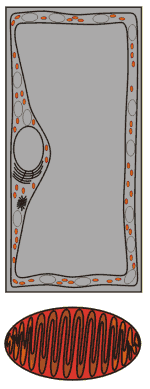 Mitochondria
Mitochondria
Organelles of eukaryotic cells, which are mainly responsible for providing the cell with ATP.
As shown in the figure, mitochondria are more or less ovate bodies in the cytosol, containing the metabolic pathways for the degradation of fatty acids and for the terminal oxidation of activated acetic acid residues (tricarboxylic acid cycle and respiratory chain). They are therefore the most important producers of ATP and are named the "power stations of the cell". As depicted in the lower part of the figure, mitochondria are composed of two membranes. The inner membrane is folded in a complex way and is the site of the respiratory chain.
Mitochondria contain the genes for some of their proteins, and for some of the enzymes necessary for producing these proteins. This observation indicates that these organelles have developed by the endosymbiosis of formerly independent bacteria.